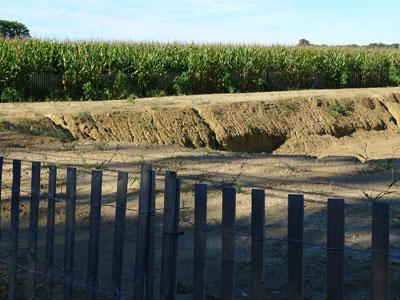Suffolk Threatens Suit Over Sump

Angered over a bungled drainage-basin project begun by East Hampton Town on county-protected farmland, Suffolk County this week served notice that it may sue the town and demanded the restoration of the prime agricultural soil that was hauled away.
It was discovered in July that the town had not consulted the county nor obtained permits for the work. The town reportedly allowed Keith Grimes, the contractor, to keep and sell the topsoil.
The project was designed to alleviate a longstanding flooding problem in a residential area across Route 114 from the farm fields that stretch between that road and Long Lane in East Hampton. To preserve the agricultural lands, the county has purchased development rights over much of that acreage.
Solutions to the flooding have been put forward over several town administrations, and Councilwoman Theresa Quigley most recently took up the issue. An engineering company was paid $35,100 to design the drainage basin, and Mr. Grimes was hired to do the work.
The project, however, required not only permission from the county as the development rights owner, but State Department of Environmental Conservation permits and an okay from the county farmland committee, which would have included an examination by soil and water conservation district representatives as to whether the proposed design and placement of the basin was acceptable.
Ms. Quigley and Supervisor Bill Wilkinson have said that they approached Elizabeth Fonseca, the landowner, who agreed last September to grant the town a drainage easement over the property. Her authority to do so, however, since the county had purchased the development rights in 1988, is in question.
The town never filed that easement with the county clerk, County Legislator Jay Schneiderman said Tuesday. That led the county to reject the town’s application for permission to build the basin, which was not filed until the problems came to light and the project was suspended.
In a release issued this week, County Executive Steven Bellone said, “The unlawful excavation and removal of topsoil rendered the land in question unusable for farming and substantially diminished the value of the land, which was paid for by Suffolk County taxpayers. We believe the flooding issue can be addressed without alienating farmland and at far less cost to the taxpayers.”
In addition, “for the County to grant any entity the approval to alienate farmland for which the development rights have already been purchased (and thus, protected from development), would require a countywide referendum,” stated Mr. Bellone.
“The county takes farmland preservation very seriously,” Mr. Schneiderman said. “These are taxpayer dollars — not exclusively town money.”
Paul Tenyenhuis, district manager of the Suffolk County Soil and Water Conservation District, who works closely with the United States Department of Agriculture on local erosion and flooding issues, said in the release that “the drainage basin the town wants to install would attempt to collect all the runoff water in one location, whereas accepted farming practices, such as planting a winter cover crop, changing the direction in which crop rows are planted, or terracing, would go a long way to reducing and eliminating the problem.”
“There are much cheaper and more environmentally sound ways to resolve the flooding issue than by hauling away for sale some of the finest agricultural soil in the State of New York,” said Suffolk County Director of Planning Sarah Lansdale in the release.
According to the county, more than five feet of soil, sand, and clay was excavated.
Mr. Schneiderman said he had suggested that the town “listen to the county planning director, and maybe make some modifications.”
If the basin is designed not only to capture runoff from the fields, but also from non-farmland property, the county farmland committee “doesn’t have the legal authority to approve it,” Mr. Schneiderman said. “Somebody’s going to have to make that determination.”
Town officials did not respond yesterday to a request for comment. But at a meeting in August, both Ms. Quigley and Mr. Wilkinson expressed dismay at the delay in fixing the flooding problem.
Ms. Quigley said then that changing the recharge-basin design to one suggested by the county would be “more disruptive to farmers” and would cost more. “My question about that is, who pays?” she said, pointing out that people whose houses had continually been damaged by floods from the fields had sued and won, and were awarded damages. “The county didn’t pay,” Ms. Quigley said. “The town paid. The county is either a partner in this with us or not.”
“While I recognize that we should have reached out to them, that’s a different issue,” she said last month.
Mr. Grimes, the contractor, has been paid $69,140 of a $293,000 contract for the work already done. The town has also spent $35,000 on engineering fees. Stopping the project, returning the soils, and restarting the work would add an additional $25,000.
The town board resolution hiring Mr. Grimes makes no mention of the disposition of the valuable farm soils. However, according to the town purchasing agent, his bid was the lowest of a number from different companies, and the deal included the topsoil.
During the town board discussion of the issue in August, Mr.Wilkinson complained about the county. “I am — to tell the public — pretty frustrated; to tell you the truth, pretty disappointed with the county,” he said. “This town gives a lot of money to the county, and doesn’t get it back in services.” The county, he said, looked at the situation “purely as an exercise that the county had a right to that particular property, and we violated it.”
“They just have to go through the proper procedures,” Mr. Schneiderman said of the town, earlier this week. “I certainly understand the severity of the flooding. I will do everything I can to help achieve a solution that’s permissible by law.”
This is the first time he can think of, he said, that the county was poised to sue a Suffolk municipality.
